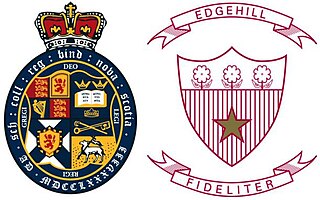
King Edward VII School is a coeducational secondary school and sixth form located in Sheffield, South Yorkshire, England.

King's-Edgehill School is a Canadian private university-preparatory boarding and day school located in the town of Windsor, Nova Scotia. It is the oldest English independent school in the Commonwealth outside the United Kingdom, founded by United Empire Loyalists as King's Collegiate School in 1788, and granted Royal Charter by King George III in 1802.

Edward Keble Chatterton was a prolific writer who published around a hundred books, pamphlets and magazine series, mainly on maritime and naval themes.

Wesley College, a school to educate the sons of the laity, opened in 1838 in new buildings designed by William Flockton on Glossop Road, Sheffield, England. It was founded by Rev. Samuel Dousland Waddy (1804–1876) to "supply a generally superior and classical education, combined with religious training in the principles of Methodism" and was initially called the "Wesleyan Proprietary Grammar School". The change in name to Wesley College seems to have taken place in 1844, when a "Royal Warrant, constituting the Sheffield Wesley College a college of the University of London was forwarded to Mr Waddy by Sir James Graham, which empowered the college to issue certificates to candidates for examination for the several degrees of Bachelor and Master of Arts, and Bachelor and Doctor of Laws". A year later it spurred Rev. James Gillman, William Ferguson, William Stewart and Thomas Waugh in Dublin, Ireland to consider creating a similar school in Dublin. The school accepted its first 90 boarders on 8 August 1838. By 1841 the number of pupils had increased to 172. In 1905 Wesley College was purchased by Sheffield Council and merged with Sheffield Royal Grammar School to form King Edward VII School, named after the reigning monarch. The building was recently refurbished, with the addition of a sports hall and science block, as part of the BSF programme
Sheffield Collegiate School began in 1836 in new buildings on the corner of Ecclesall Road and Collegiate Crescent. The school enjoyed academic success but lacked sound finances and was taken over by Sheffield Grammar School in 1884, to become Sheffield Royal Grammar School (SRGS) in 1885.
Nathaniel Langford Clapton, the only son of Nathaniel Clapton, ironmonger's manager, of St Dunstan's Crescent, Worcester, was a prominent schoolmaster.
Formal education in Sheffield, England, takes place at the city's two universities, 141 primary schools and 28 secondary schools.

King Edward VII School (KE7) was an LEA maintained 11-19 comprehensive secondary school in Melton Mowbray, Leicestershire in England which closed in 2011. The school was situated on a 56-acre (230,000 m2) green field site on the edge of Melton Mowbray. Formerly, the school was a public grammar school. A third phase specialist technology college, Microsoft Partner School, CISCO Academy and training college, the school received a range of awards for its work.
John Philipps Kenyon, FBA was an English historian and Fellow of the British Academy. His area of expertise was 17th-century England.
Ludwig Glauert MBE was a British-born Australian paleontologist, herpetologist and museum curator. He is known for work on Pleistocene mammal fossils, and as a museum curator who played an important role in natural science of Western Australia.
George William Kinman was Headmaster of Hertford Grammar School from 1905 until his death in 1927. He also headmaster at Dolgelley Grammar School, Chairman of the Ware Education Committee, and a Major in the British Army.
Charles Daubuz or Charles Daubus (1673–1717), was a Church of England clergyman and theologian.

(George) Adrian Horridge FRS FAA is an Australian neurobiologist and professor at Australian National University.
Marlborough Royal Free Grammar School, previously known as Marlborough Grammar School and King Edward's School, Marlborough, was a grammar school in the town of Marlborough, in Wiltshire, England, founded in 1550.
King Edward VII School is a premier secondary school for boys located on Jalan Muzium Hulu, in Taiping, Malaysia. Formerly known as Central School, it is one of the oldest schools in Malaysia. The school is widely known as by its initials "KE7". The students are known as Edwardians or Tigers and, as alumni, Old Edwardians.
Henry John Chaytor (1871–1954), British academic, classicist and hispanist, was Master of St Catharine's College, Cambridge from 1933 to 1946.
Prof (Major) Morley Hodkin Sewell MRCVS was a British veterinarian who served as Dean of the Dick Vet School in Edinburgh from 1994 to 1997. He was an expert on tropical diseases of animals.

King Edward VII School (KES) or King Edward School Lytham was a grammar, direct grant grammar and independent school for boys, founded in 1908 and situated in the coastal town of Lytham St. Annes, Lancashire. The school was merged with Queen Mary School for girls in 1999, and was renamed to create the co-educational King Edward VII and Queen Mary School (KEQMS)






